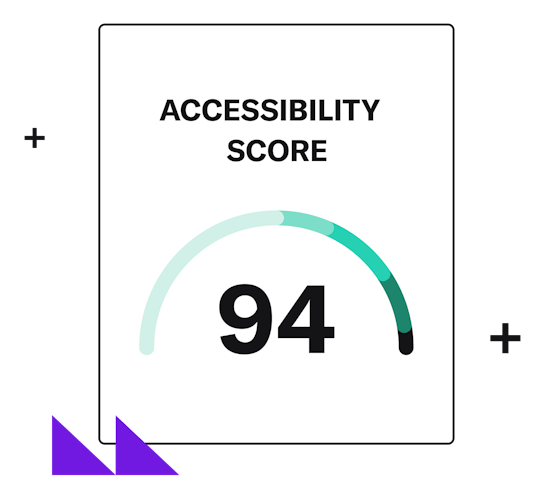California Website Accessibility and Compliance Software
On This Page
The State of California is one of the most advanced in the U.S. when it comes to ensuring equal rights for people of all physical abilities. California has supplemented federal laws (Section 508 of the Rehabilitation Act and the Americans with Disabilities Act) with its own state-level legislation to prevent discrimination against people living with disabilities. For state agencies and entities, the relevant state-level legislation is California Assembly Bill 434 (AB 434), introduced in 2019. For businesses, the relevant legislation is California Civil Code §51, usually referred to as the Unruh Civil Rights Act. Learn more about California compliance.
Web Accessibility in a CA State Agency / Entity
If you’re responsible for website accessibility in a California state agency or entity, you must comply not only with the federal law – Section 508 – but also with the state law – California AB 434. Similarly, if you operate a business in California, you must comply not only with the ADA (federal) but also with the Unruh Civil Rights Act (state).
Some interpretations of the law argue that the Unruh Act even applies to out-of-state businesses that have customers in California but no physical presence in the state. For example, a 2020 lawsuit (Thurston v. Fairfield) in the Court of Appeals of California determined that a Georgia-based online retailer fell under the jurisdiction of the Unruh Act. Read more about how the Unruh Act was used in a digital accessibility lawsuit for another out-of-state business.
What is California Assembly Bill 434 (AB 434)?
Effective July 2019 onwards, California AB 434 requires that all websites of state agencies and entities must be accessible to users of all abilities. Specifically, websites must conform (at minimum) to Level AA of the W3C’s Web Content Accessibility Guidelines (WCAG) 2.0. Even before the introduction of California AB 434, Californian state agencies and entities were required to comply with Section 508 of the Rehabilitation Act – a federal law applicable to all agencies in receipt of financial assistance from the federal government.
So, even though local (county and municipal) government organizations are not required to comply with California AB 434, they almost certainly fall under the jurisdiction of Section 508. And as Section 508 also requires conformance to Level AA of WCAG 2.0, this effectively puts all government organizations in California under the same legal obligations to ensure online accessibility.
California AB 434 and the Americans with Disabilities Act (ADA) Title II
Title II of the ADA applies to state and local government entities throughout the U.S., prohibiting discrimination on the basis of disability in all services, programs, and activities provided to the public. Like California AB 434 and Section 508, Title II of the ADA uses WCAG conformance as the benchmark for measuring compliance.
California AB 434 and the Web Content Accessibility Guidelines (WCAG)
California AB 434 requires all state agencies in California, and any contractors working for them, to ensure that their websites conform to Level AA standards of WCAG 2.0. Level AA is the goal that most organizations aim for, not least because some elements of Level AAA conformance are unlikely to be achievable in practice.
Under AB 434, all state agencies in California must display on their home pages a signed certification that they conform to Level AA of WCAG 2.0. To stay ahead of the curve, AudioEye always rapidly adopts the latest WCAG standard – currently 2.1 – and assists organizations in achieving and maintaining substantial conformance with WCAG Level AA criteria.
WCAG sets out four key principles, requiring website content and controls to be:

Perceivable
A website is deemed to be perceivable if both the information it contains (its content) and the components of its user interface (clickable links, text boxes, buttons and so on) are presented so that all users can perceive them using one or other of their senses. In other words, if any of a website’s content or controls are invisible to any user, then the website fails the perceivability test.

Operable
A website is deemed to be operable if all users can interact effectively with the user interface to navigate the website. If the website contains interactive components, then all users should be able to operate those components. If the interface requires the user to interact in a way that is impossible for them, then the website fails the operability test.

Understandable
A website is deemed to be understandable if both its information (content) and its user interface components can be readily understood. If a user cannot understand how a website works or what the information on the website means, then it fails the understandability test.

Robust
A website is deemed to be robust if it can be interpreted by the full range of possible user agents—not only standard web browsers, but also assistive technologies such as screen readers. And this is not a one-off goal: as user agents and technologies continue to evolve, the content must remain accessible.
What is the Unruh Civil Rights Act?
Enacted in 1959, California Civil Code §51 is more commonly known as the Unruh Civil Rights Act after its author, Jesse M. Unruh. The act stipulates that “all persons within the jurisdiction of [the State of California] are entitled to full and equal accommodations in all business establishments regardless of their sex, race, color, religion, ancestry, national origin, disability, medical condition, genetic information, marital status, or sexual orientation.”
California ADA Website Accessibility Compliance and the Unruh Civil Rights Act
The Unruh Civil Rights Act was updated in 1992 to include people with disabilities in the list of those entitled to full and equal accommodation. At the same time, the act adopted the standards set by the ADA, so that failure to achieve ADA compliance also equals failure to comply with Unruh – a fact repeatedly confirmed by judges in California.
Many U.S. courts have consistently ruled that websites are included among these places of public accommodation. This was tested at the highest level in 2019, when the U.S. Supreme Court denied petition from Domino’s Pizza, letting stand the two lower court rulings that the ADA does indeed apply to the accessibility of websites.
A successful ADA lawsuit pays no damages to plaintiffs – they receive only their legal fees. By contrast, each violation of Unruh entitles the plaintiff to damages ranging from a minimum of $4,000 up to three times the actual damages incurred, which can include emotional distress.
For businesses concerned about the financial risks around Unruh compliance there is at least one comforting precedent: a 2018 California state court ruled that “repeated visits to the same inaccessible website [did not] establish a separate offense within the meaning of the Unruh Act.” (Thurston v. Midvale Corp.).
Risks and Benefits of California Website Accessibility Compliance and Non-Compliance
Recent years have seen sharp increases in the number of website accessibility lawsuits in California, in particular for violations of the Unruh Act. For businesses, a digital accessibility lawsuit means not only the risk of $4,000 in damages for each violation, but also the potentially far more significant time, cost and reputational damage involved in defending an accessibility lawsuit.

Businesses in California that achieve compliance with the Unruh Civil Rights Act (and, by extension, with Title III of the ADA) benefit not only from reduced legal risk but also from great improvements in user experience and the ability to reach much larger audiences. In the U.S., 61 million adults are living with a disability; worldwide, people with disabilities control an annual disposable income of $1.2 trillion. Businesses can therefore potentially achieve a considerable return on their investments in website accessibility.
For state and local government organizations, compliance with (as applicable) California AB 434, Section 508 and Title II of the ADA means reduced legal risk, improved ability to attract and retain the most talented employees regardless of physical ability, and enhanced ability to deliver services to all citizens.
How Do You Know if Your Website Meets California Website Accessibility Standards?
While organizations in California face the burden of compliance with both federal and state laws around website accessibility, the good news is that the technical requirements for all these pieces of legislation boil down to achieving substantial conformance to Level II standards of WCAG 2.0

To assess your website’s performance on the four principles of WCAG accessibility means carrying out extensive testing – not just once, but on an ongoing basis whenever the content or structure of your website changes. Free tools such as accessibilitytest.org can be a great help, but they can only ever identify a small fraction of accessibility issues. Equally, many of the WCAG guidelines are subjective, so you need to bring human expertise and judgement into the equation.
To help meet California accessibility standards, the optimal approach is to combine automated compliance software, such as AudioEye’s advanced AI-powered scanning, with expert consultancy for detecting and fixing errors.
How AudioEye Hybrid Accessibility Solutions Can Help
AudioEye’s hybrid platform combines intelligent, automated compliance software with certified accessibility experts and testers to give you the best chance of complying with any relevant legislation: California AB 434, Section 508 of the Rehabilitation Act, the Unruh Civil Rights Act, and Titles II and III of the ADA.
AudioEye’s holistic approach includes automated and manual identification and assistive technology testing, accessibility reporting, ongoing maintenance and monitoring, web personalization tools, training resources, and AudioEye Trusted Certification.
Fast-track your journey to web accessibility compliance with a free 14-day trial of AudioEye today!